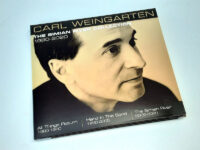This is the record that changed the game for both New Age and solo acoustic guitar music. Aerial Boundaries introduced the world to the amazing guitarist Michael Hedges, immediately catapulting him to guitar superstardom and beginning a twelve year reign as one of the world’s very best living plectrists until his life was suddenly snuffed out in a car wreck in 1997.
Audio Fidelity has taken this classic 1985 Windham Hill disc and applied some remastering alchemy to it. All that fleet fingerpicking, the hammer-on’s, pull-off’s and the open-string harmonics are all heard clearer than ever, making Aerial Boundaries a re-revelation of the endless possibilities from an acoustic guitar.
It’s not just technique that puts Aerial in a lofty position as one of the best guitar records ever; Hedges crafted songs that gave purpose for all that heady technique. Sounding like three guitarists at once, Hedges lets an evolving ostinato of the title song unfold with the subtle genius of Terry Riley minimalism and undertakes bass and percussion roles with economical involvement.
“Rickover’s Dream” is a complex, extended but beautifully pastoral melody, punctuated by occasional, startling percussive strikes on the guitar. Moreover, Hedges carefully tempers the emotion, allowing the song to ebb and flow like a symphony. His ability to generate several, parallel parts at once enables him to forge syncopations that are staggering, such as what is heard on “Ragamuffin” and the funky “Hot Type.”
Hedges is joined by guest artists, but only sparingly: Michael Manring contributes the lyrical part to Neil Young’s “After The Gold Rush” (the album’s only cover), using his fretless bass with an emotional heft called for by the original. Manring along with flautist Mindy Rosenfield also joins in for “Ménage à Trois,” a beautifully mysterious melody accentuated by Manring’s bass solo similar in lyricism to Eberhard Weber. Hedges is meanwhile filling up so much space with rich resonance that adding the other two makes it seem that the performance is played by a much larger band than a trio.
The risk taking by Hedges extends to the technological side as well for the finely layered “Spare Change,” where electronic effects and looping only serves to illuminate the guitarist’s mastery of harmony and sonority, not gloss over it. Clearly, Hedges would have thrived with the on-the-fly sampling and looping available to musicians today, because he was already anticipating its potential here.
Michael Hedges did nothing less than bring the acoustic guitar into the New Age realm and completely conquer it within the space of this record. He was the rare subversive who bucked convention in the most ingratiating and immediately satisfying way. It was astounding to hear Aerial Boundaries thirty years ago and the Audio Fidelity version is reason enough to be astounded all over again.
- David Torn – ‘Adityahridayam 321’ (2024) - May 5, 2024
- Ivo Perelman + Matthew Shipp – ‘Magical Incantation’ (2024) - May 4, 2024
- Tomeka Reid Quartet – ‘3+3’ (2024) - April 30, 2024



